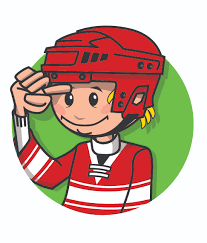Top Content Title
This is an additional section to be able to add content

How should the hockey helmet fit?
For an adjustable helmet, open it to the largest setting and gradually begin to downsize the helmet until a comfortably snug fit is achieved. The helmet should rest on the head so that the rim is one finger width above the eyebrow and making contact with the top of your head.
A hockey helmet should fit snug to prevent any shifting and maximize protection. Make sure the chinstrap can be adjusted so it gently makes contact under the chin when fastened.
All CSA certified helmets have a sticker indicating their certification.
Although most helmets are lined with protective foam, some helmets will feel better than others. Try on different brands of helmets for fit and comfort.
Why only hockey helmets?
Hockey helmets are designed to help protect against head injuries occurring on ice, whether from a fall or collision. A bicycle helmet, for example, is designed to protect against head injuries should a fall occur while riding a bicycle. It is important to ensure that when a skater is on the ice, they are protected with equipment designed for their sport or activity.
Are helmet cages or visors required as well?
They are not mandatory; however young skaters may benefit from the added protection.
Are used hockey helmets acceptable?
Hockey helmets and face protectors sold in Canada must meet safety standards set by the Canadian Standards Association (CSA). If the CSA sticker is not present, throw the product away. Hockey helmets normally last for about three to five years. Hockey helmets must not be used if previously subjected to a major impact or if older than five years or if showing visible signs of damage or if parts are missing. Hockey helmets must have labeling with the date of manufacture and have a chin strap. It is important that the helmet fit properly in order to ensure proper protection.
Can a parent sign a waiver absolving the club from any liability and allow their child to participate without a helmet?
No. The requirement to wear a helmet is a Skate Canada Policy and all clubs and members must abide by our policies. Therefore in order to participate in the CanSkate program all skaters who have not achieved Stage 5 in the CanSkate program or who lack good balance and control must wear a CSA approved hockey helmet while on the ice.
Why has up to and including Stage 5 been selected as the benchmark for helmet use?
Skaters who lack good control/balance when skating forward, backward and have difficulty stopping, as well as maneuvering around obstacles on the ice are at a higher risk of being unable to control a fall, regardless of their age.
The CanSkate program has been developed to introduce basic skating skills to beginners in a safe and sequential manner. The learning progressions leading to and included in Stage 5 allow skaters to gain the necessary skills (balance, agility, and control) required to safely participate on the ice. While it may be likely that many Stage 5 skaters can skate reasonably well, ice surfaces can be very unpredictable and there is always a risk of falling, no matter what stage a skater is at. CanSkaters participate in a group environment with other skaters on the ice of different levels who may fall and cause other skaters to fall.
What other tips could you provide regarding prevention of falls and head injury?
There are several ways to avoid head injury, in addition to wearing a helmet. The following are some basic guidelines:
- Use quality equipment - skates with good support, proper fit, laced correctly and sharpened regularly help the skater maintain control on the ice – therefore less chance of falling
- Dress appropriately – no scarves, overly bulky snowsuits, or hair in the face as this may restrict movement, visionWarm up and cool down appropriately - to avoid muscle strain and stress on the joints
- Use skill progressions to prepare for more difficult moves; coach must ensure that beginners are taught proper way to fall and get upEnsure coaches have valid first aid certification
- Group activity and practice areas must be well-supervised; during skill circuits and drills, skaters should be travelling in one direction to avoid collisions.
- Use pylons to mark any holes or cracks on the ice.
- Teaching aids must be safe and appropriate for the level of skater.
- Ensure sufficient space between skaters while executing skills.
- The number of skaters on the ice should be appropriate to the size and skill level of the skaters, the size of the ice surface and the nature of the activity.
- Enforce on-ice safety rules:
- look in the direction of travel when skating backwards o no pushing, playing tag or other horse play
- no gum or candy on the ice
- keep rink doors closed during session
- stops should be done a safe distance from the boards
- keep first aid kit accessible
How can I identify a hockey helmet that is CSA approved? Where will the logo appear on the hockey helmet?
The CSA approved logo will be found on the back of the hockey helmet affixed to the outer shell of the helmet.
For more information about CSA standards visit CSA International.
Bottom Content Title
This is an additional section to be able to add content
